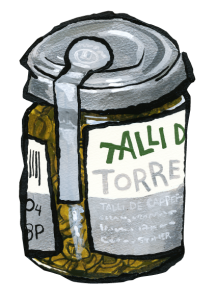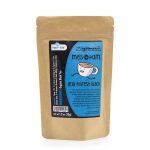Val Talks Capers (pt. 2)
Val Neff-Rasmussen recently travelled to Italy on a buying trip for Zingerman’s Mail Order. This essay recounts her visit to the island of Pantelleria, source of some of the best capers in the world.
Capers: From Field to Fork (pt. 2)
From bud to caper
Everyone on Pantelleria says that raw caper buds are inedible. They’re not poisonous (as I am happy to report from personal experience, since I tried them for myself while I was there), but they’re not all that tasty, either. The flavor is something like a green pea, but more bitter and with a harsh peppery bite not unlike arugula. The capers you buy aren’t raw; they’re cured. Curing serves two purposes: it highlights the delicate, floral aromas for which capers are prized, and it preserves them for year-round use.
In other parts of the Mediterranean capers are cured in vinegar or a salt brine. On Pantelleria they use only sea salt. Partly this is done for flavor—curing in vinegar can mask the flavor of the caper itself—but partly it is just a matter of practicality: with no fresh water and little rainfall, there’s no water to spare for caper curing. The capers salt for about three weeks, during which time they undergo a lactic fermentation, the same process used to cure sauerkraut or kimchi.
After three weeks of curing, the farmers bring their capers to the capperificio, or caper maker. The term sounds fancier than the reality; the capperificio I visited on Pantelleria was a small warehouse crammed full of bins and buckets of all sizes filled with countless capers waiting for processing. In the corners, huge bags of sea salt sat in heavy stacks. More salt was lodged in the narrow crevices of the red brick floor. The air was thick with the intensely briny, slightly floral aroma of the capers.
After the farmers deliver the capers, the capperificio’s first job is to remove the curing salt (some of which, I was told, is sold off for use in beauty creams). Then the capers are sorted by size: small, medium, large, and berry (more on this in a moment). The sorted capers are then packed in fresh salt in tall barrels, where they’re kept until they’re packed to order.
The result of all this work—growing the capers without irrigation, hand-picking, traditional salt-curing, and all the rest—is a caper that’s renowned as one of the best in the world. The capers of Pantelleria are firm, green, floral, savory, almost toasty, as if I could taste the time they spent growing under that hot Mediterranean sun. They pack big flavor in a tiny parcel.
Buying and cooking with capers
When choosing capers, look for ones that are packed in salt rather than vinegar or olive oil which can mask the briny, floral flavor of the capers. When using salt-packed capers, most Pantescans prefer to rinse the salt off before using them. There’s no consensus on the right way to rinse a caper. One cook told me he never rinses his at all, but just doesn’t add any salt when he cooks with them. Another Pantescan suggested that he likes to rinse his capers under running water for a couple of minutes, but also advised that others prefer to let their capers soak for three to four hours. “Then you taste, and you see if you like,” he told me. (He didn’t tell me what to do if you did not like.) In general, the longer you rinse or soak your capers, the less salty they’ll be, to a point.
After rinsing your capers, you should add them only at the end of your cooking, as you would fresh herbs. Cooking capers for too long will make them mushy and leach out some of their flavor.
Pantescans use different sized capers for different purposes. Small capers have the most subtle aroma and the firmest texture; they’re great for a nice pop when bit, so they do well in a salad or over grilled fish. (The small ones are also usually the most expensive—capers are sold by weight, and it takes more labor to hand-pick a kilo of small capers than a kilo of large ones.) Large capers are mushier but have a stronger flavor making them ideal for uses where texture doesn’t matter, such as for grinding into pestos. Middle-sized capers are, as you might expect, the happy medium of fairly firm texture and somewhat bigger flavor. On Pantelleria, capers show up in just about every dish. An antipasto plate of fresh, milky tuma cheese, sun dried tomatoes, and fat purple olives includes a pile of small capers. Pasta is served sauced with a caper and almond pesto and topped with crunchy toasted breadcrumbs. A staple summer salad called insalata Pantesca contains cooked potatoes, diced raw tomatoes and onion, and capers. Filets of fish are garnished with chopped tomato and a few capers. Dessert is caperfree—at least the ones I had.
– Val





Zingerman’s Art for Sale